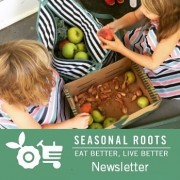11 tasty tips to boost flavor
The Flavor Fairy tells all!
– By the Flavor Fairy:
Full disclosure: There are some flavor elements you can’t do anything about. Mother Nature gets a say in the flavor of your food because she controls the weather. Like the way cold snaps sweeten up greens, or the way dry weather can boost the flavor of fruiting crops like tomatoes. Those tomatoes will wind up with a lot more flavor than you’d get from a very wet season — if the farmer relies on mulches, soil that’s full of organic matter that retains moisture, and a little irrigation.
But take it from me, the Flavor Fairy: You have the power to boost flavor, too, and you don’t need Mother Nature’s wondrous weather or a magic fairy wand to do it. Here’s how.
1. Start with fresh, local produce and artisan fare.
The Veggie Fairies who bring you your local food will tell you that there are many reasons to eat local food. Well, yours truly the Flavor Fairy is here to tell you that there’s only one reason, and one reason only: FLAVOR. Seriously — fresh, local food just freakin’ tastes better!
But okay, I’ll admit that with local food, taste and nutrition do go hand in hand. The sooner you eat food after it’s harvested or made, the more flavor and nutrition will still be inside there to be eaten, since both immediately start to fade after harvesting and making. But as far as this Flavor Fairy is concerned, the extra nutrients are just a nice bonus. The flavor boost is what it’s all about!!
As I’m sure you know by now, fresh, locally grown produce and freshly made local foods have a big advantage over the stuff in the supermarket because it doesn’t have to travel as far or as long. So it’s fresher. Plus local farmers can choose to grow things for their flavor, not their ability to withstand long trips and still look good. Many so-called improvements (more productive, disease resistant, tough enough to withstand the rigors of long-distance shipping) have been made at the expense of taste (and, okay, nutrition, too.)
(This profile of the Flores family farm explains it all!)
2. Prep garlic and onions at the last minute.
Chopping them up unleashes sharp odors and strong flavors that just keep getting stronger and stronger until they’re overpowering. Frankly, this Flavor Fairy is horrified at the thought of chopping up any fruits and veggies that you aren’t going to eat right away — the longer you expose the interiors of fruits and vegetables to light and air, the faster the flavor and nutrients escape, never to return. So, whenever possible, wait with the chopping.
3. Keep all those tomato seeds and the goopy stuff, too.
Think they’re gross? The Tough Love Fairy says: Get over it. Most of the flavor is in the seeds and surrounding jelly, not the flesh and skin. Who knew?!
4. Boil it NOT!
Lightly steam or briefly sautee greens instead of boiling them. For root veggies, you can roast, grill, or braise them instead of boiling. When you boil veggies and then discard the water, you’re tossing the flavor, and the nutrients, too. But if you do boil…
5. …Save the broth!
Boiling is fine for some things. After you boil proteins like legumes and meat, save the leftover liquid for recipes that call for broth. It’s flavor-rich and (bonus!) nutrient rich, too.
6. Strike when the pan is hot.
When you sautee or stir fry, don’t rush the preheating. A hot pan seals in flavor. So wait for the oil to shimmer before adding veggies to an empty pan. Before adding meats to an empty pan, wait for the first wisps of smoke to rise from the oil.
7. Add a wee splash of cider vinegar, salt, or sugar.
Vinegar and salt brighten up the flavors of veggies and proteins, especially soups and stews. Reach for the sugar when you’re browning something. Browned food tastes better, and a pinch of sugar speeds it up. Sprinkle on veggies and lean proteins like chicken, pork, or seafood.
8. Add soy sauce or anchovies.
They contain natural glutamates, which enhance savoriness. Add a teaspoon or two of soy sauce to chili, or cook a few minced anchovies along with the vegetables in a soup or stew.
9. Add fresh herbs at the right time.
Hardy herbs like thyme, rosemary, oregano, sage, and marjoram can go into whatever you’re making early in the cooking process. They need time to soften up and release their maximum flavor. Save delicate herbs like parsley, cilantro, tarragon, chives, and basil for the last minute. Add them too early, and all their fresh flavor and bright color will be lost — and that breaks this Flavor Fairy’s heart.
10. Use fat to intensify dried spices.
Cook ground spices and dried herbs for a minute or two in a little butter or oil before adding liquid to the pan. If you’re sautéing something like onions, wait until they’re nearly cooked before adding the spices to the fat in the pan.
11. Oh, and keep those fats fresh!
Ever tasted a rancid almond or oil that’s turned? It’ll give you a prune face for sure. Keep those off-flavors out of your cooking by keeping on hand only as much fat as you can use promptly. While your fats are waiting to be used, store them in ways that limit their exposure to oxygen and light to slow down the process that turns them rancid. Extra butter and nuts go in the freezer, nut oils go in the fridge, and vegetable oils go in a dark pantry.
ABOUT SEASONAL ROOTS
Since 2011, Seasonal Roots’ online farmers market has connected Virginia families with local family farmers who use sustainable, humane practices. Our veggie fairies – mostly moms who believe in living better through scrumptious, healthy eating, being kind to animals, protecting the environment, and spreading joy – home-deliver freshly harvested produce, eggs, grass-fed dairy and meat, plus artisan fare. We empower our members to eat better and live better with more nutritious, flavorful food that’s good for us and good for the planet. More info at seasonalroots.com.






















